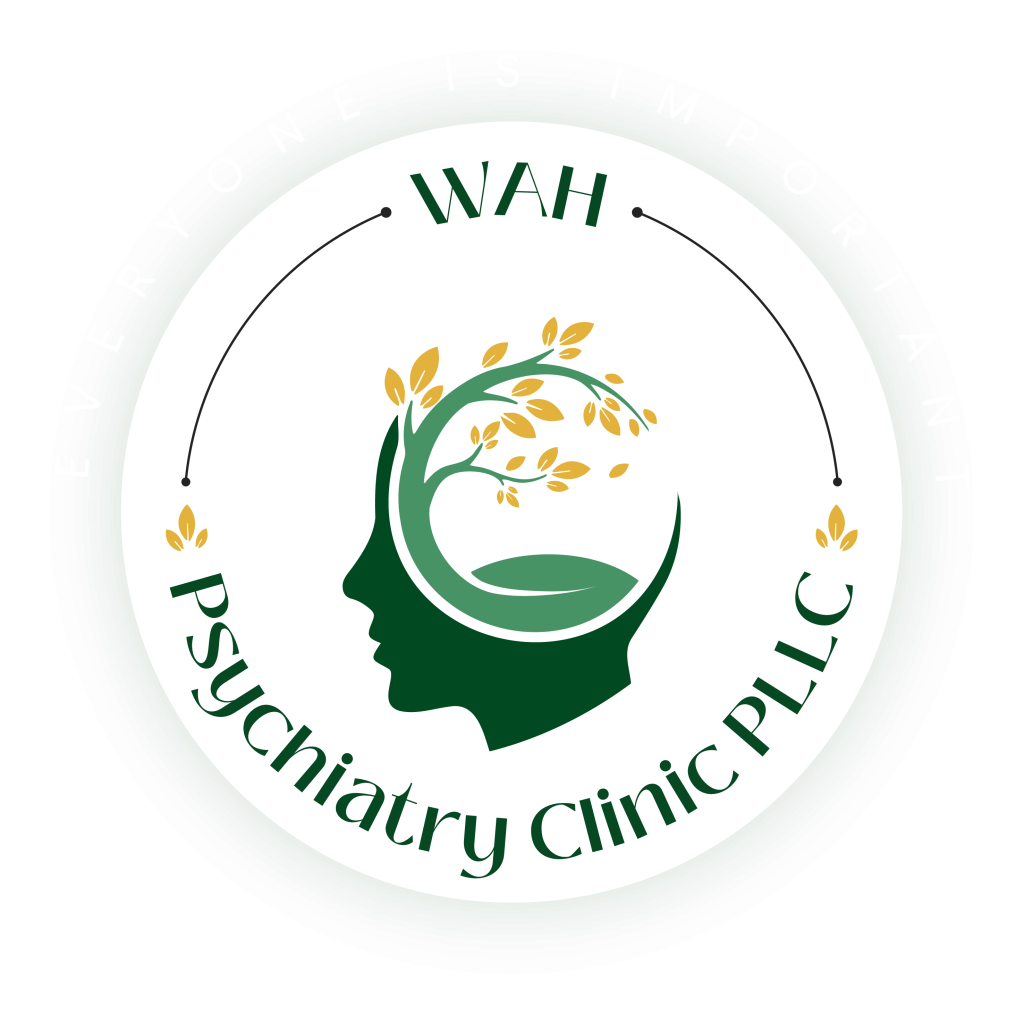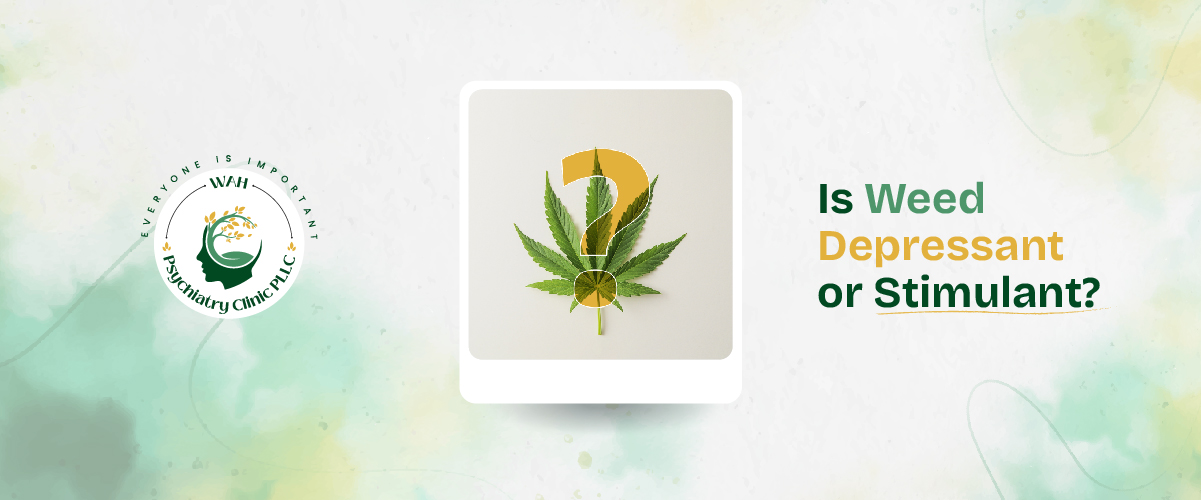People call Weed, marijuana, or even pot. It’s just the dry parts flowers, leaves, and seeds of the Cannabis sativa plant. This plant can change how you feel or what you think. In some states, it’s used for medical and fun stuff. But not everywhere! Let’s explore “is weed a stimulant or depressant?”
Are you facing mental health struggles or depression? Wah Psychiatry Clinic offers personalized care to help you. Contact us today to start your journey to better health.
About Weed
Marijuana serves medical and leisure needs. Many use the leaves, essence, and different sections of the herb to calm ongoing discomfort and varied signs. Standard methods of utilizing weed are:
- Smoking or vaping
- Brewing as a tea
- Consuming in food (edibles)
- Using as capsules or supplements
Tetrahydrocannabinol (THC)
Weed’s key mind-changing part is tetrahydrocannabinol, often known as THC. It’s the chemical behind weed’s tricks on the mind as it plays a copycat to the body’s innate cannabinoid chemicals. THC latches onto certain brain receptors. These receptors are linked with movement, joy, thought processes, recall, and our sense of time. And when THC and these receptors mingle, it impacts coordination, satisfaction, cognition, memory, and time awareness.
Effects on the Body: Is Weed a Stimulant or Depressant?
Interestingly, THC can serve dual roles. It triggers a feel-good sensation by prompting your brain to release dopamine, which generates happiness. However, it also disrupts your hippocampus’s information-processing capabilities, possibly leading to problems with short-term memory.
Depressant vs Stimulant Effects
Weed as a Depressant
Marijuana can ease your nervous system and make muscles restful. Comparable to alcohol or Xanax, it can relax anxiety. With continued use, your body might get used to THC, needing more for the same calm. Long-term use may result in reliance.
Weed as a Stimulant
Alternatively, weed can function like a pick-me-up. It revs up your heart rate and blood pressure, which may perk you up and make you feel livelier, particularly after use. The elevation in the mood it provides might lead a few people to rely on weed to feel upbeat.
Hallucinogenic Properties
Can weed make you hallucinate? It’s uncommon, but weed might trigger these effects, mostly if used a lot. This might include feeling a time shift, such as sensing that time is going unusually slow or speeding up.
Risks of Weed Use
Weed appeal lies in its effects, but they could also pose threats, particularly to individuals with mental health conditions. THC, for instance, can worsen schizophrenic symptoms. Moreover, motor skills could be hampered by weed use, impacting activities like driving for about three hours post-use. If weed use is long-term and begins from a tender age, it may negatively affect memory and cognitive abilities.
Classification of Drugs
Drugs have various impacts on the human body, falling into different groups according to their effects. Let’s see:
- Depressants: Make your brain slow down.
- Stimulants: Lift your alertness and mood.
- Hallucinogens: Mess with your sense of reality.
- Opiates: They make you feel super good.
Is Weed a Stimulant or Depressant?
Asking if weed is a stimulant or depressant isn’t simple. Weed’s impact can drastically differ among people and types. Some might feel calm or drowsy, others might feel awakened and lively.
Weed and Xanax
Marijuana and Xanax share a calming quality, though they function distinctively within the body. Marijuana is plant-derived, acting as either a stimulant or a depressant. Conversely, Xanax is a prescribed medication targeting anxiety and panic disorders by reducing brain functions. Their combination heightens their tranquilizing attributes, potentially resulting in excessive sleepiness, befuddlement, and potential risks, such as breathing issues.
Is Opium a Depressant?
Opium, indeed, is a downer. It dials down your central nervous system. What does this do? It muffles pain, chills you out, and might even lull you to sleep. Drugs like morphine and heroin are siblings of opium. Great at numbing pain, but hold up! They carry a heavy risk of addiction. Misuse it, and it’s in severe danger, especially if in big doses.
Which of the Following Drugs is Not a Hallucinogen?
Trippy stuff like hallucinogens, they mess with your mind. They play tricks on your senses, making you imagine stuff that’s not really there. You’ve probably heard of LSD, “magic” mushrooms (psilocybin), and raves’ favorite, MDMA (ecstasy). Yet it’s crucial to know, that not all substances do this. See that cocaine? It’s all about stimulation. And heroin? That’s an opiate. Neither give you those visions.
Interactions with Other Substances
Merging cannabis with different drugs can greatly shift its impact. People often combine it with substances such as PCP, heroin, LSD, meth, ketamine, or cocaine to amplify its mind-altering attributes.
PCP-Laced Weed
PCP, a risky mind-altering substance, can boost the intensity when combined with weed. This combo could cause breathing problems, fits, thoughts of self-harm, hostility, false beliefs, imagined sensations, and lasting brain disorders.
Heroin-Laced Weed
When someone smokes weed mixed with heroin, they might feel overly tired, and bewildered, and notice a slower heartbeat and breathing. These effects all together can make a person unresponsive. In more serious situations, it can result in an overdose.
Cocaine-Laced Weed
Mixing marijuana and cocaine, an activator can cause an unusual group of mind-altering signs. Although the lively effects of cocaine offset the calming effects of marijuana, this blend can result in fear, fits, heart problems, and illusions.
LSD-Laced Weed
LSD is a strong substance that can stir up vivid visions. If mixed with weed, it can cause a prolonged and powerful dreamlike journey, which often keeps on for 12 hours.
Meth-Laced Weed
Crystal meth, a strong stimulant, and weed can combine to cause strong reactions. These can include false beliefs, visions, not understanding what real, and possible fits is.
Ketamine-Laced Weed
Ketamine, often found at parties, may produce out-of-body and energizing results when used with marijuana. This combo can generate extreme heat and intense thirst.
Is Weed Addictive?
Using weed routinely might result in a weed use disorder. In extreme instances, this disorder can show up as an addiction. Relying on weed can bring about withdrawal symptoms like trouble sleeping, mood swings, irritability, nausea, intense needs, restlessness, a decrease in appetite, and other body aches when quitting. Addiction happens when a person can’t quit using weed even though it impacts their life negatively.
Medical Uses of Weed
The medicinal benefits of weed include pain control and symptom relief for long-term illnesses. It’s useful for treating issues such as epilepsy, multiple sclerosis, and ongoing discomfort. In these situations, weed’s potency with muscle relaxation and inflammation reduction shows its value.
Recreational Use and Legalization
Pot legalization for fun activities is on the rise. Where it’s allowed, people can buy it from authorized stores. Still, smart marijuana use is key to steer clear of possible harm to health and happiness.
Comparison with Other Substances
When you look at depressants and stimulants, the place of weed seems unique. It’s not like pure sedatives such as Xanax or pure energizers like cocaine. Weed can have influences belonging to both types. This two-sided characteristic makes it adaptable but also a bit tricky to completely grasp.
Social and Cultural Impact
Weed holds a sizeable role in society and culture. It’s frequently shown in media and pop culture, shaping how people see and accept it. As it becomes legal in more places, its cultural value keeps changing.
Future Research
Doing research is key to fully grasp the impact of weed. Ongoing studies on long-term effects, specifically concerning mental health and brain function, are crucial. These investigations guide future rules for using weed safely.
Tips for Safe Use
- Start Small, Take it Easy: If you’re a newbie to weed, begin with a small quantity and slowly raise it if required.
- Learn the Legislation: Understand your state or country’s weed rules.
- Don’t Combine: Refrain from blending weed with other stuff, notably alcohol or other narcotics.
- Give Attention to Mental Health: Handle weed with care if you’ve ever had mental health troubles, and always seek advice from a medical expert.
Conclusion
Is weed a stimulant or depressant? Weed can function as both a stimulant and a depressant, varying with each person and strain. It also might cause vivid visions, although this is not the norm. It’s essential to grasp the wide-ranging impacts of weed and the dangers linked to its use, especially when combined with other substances, to decide wisely about its usage.
By understanding these aspects, individuals can make more informed choices about weed use and its place in their lives.
FAQs
Q. Is weed a stimulant or a depressant?
There’s a plant called weed, also known as marijuana. Its effects vary. Sometimes, it can pep you up, making you feel energetic. Other times, it can settle you down, making you sleepy. Things like the type of weed and your body’s reaction influence this.
Q. Is heroin a stimulant or depressant?
Heroin is a type of depressant. This means it chills your nervous system. It can help you relax, and ease your pain. Yet, it’s risky. It could get you addicted and harm you.
3. What is Mary Jane drug?
“Mary Jane”, a casual term for cannabis, encompasses the dehydrated blossoms, foliage, and kernels of the plant. Its mental shift effects are applied for pleasure and health purposes.





No comment